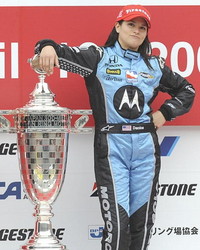Female Racers Still Looking For Respect - Part 1
 |
Commentary by Rick Carlton
According to the National Women In Racing Directory, at the end of Q4 there were 1,819 drivers actively participating in sanctioned events at all levels of motorsport. However, in investigating the database, the number of recurrent top or development level drivers, i.e. those who are branded athletes racing in Sprint Cup, Nationwide, Camping World Trucks, Firestone Indy Lights, Grand Am's Continental Tire Sports Car Challenge, and ALMS' GT Challenge, the number drops to a paltry total of 17, in comparison with several hundred male entrants.
To some degree, the lack of substantive consumer automotive, financial, technology, supply-chain and healthcare firms who are represented by female athletes may be a legacy event, since motorsports continues to be largely perceived as a male endeavor. Regardless, some women have generated increased commercial attention in the last several years, but in general, advertising agencies, marketeers and sponsors continue to be slow to leverage female motorsports personalities.
One the face of it, there are some indicators that may relate to what is going on. In an obvious example of positive marketing gone wrong, consider the value proposition based on Danica Patrick's Go Daddy branding. When Patrick came through the lower motorsports ranks, her reputation was that of a hard-charging racer who was entirely capable of beating male competitors corner for corner. At the same time, she efficiently portrayed herself as being talented, smart and clearly confident off the racetrack, and that image held her in good stead as she grew in prominence as an emergent promotional partner.
However, somewhere between her original market messaging, and today's exceedingly crass Go Daddy packaging, Danica allowed herself to be perceived as a bikini model who races, as opposed to a professional race driver who happens to be a model. As a result, her value has been diminished commercially by continually promoting messages that defeat the value of a woman's intelligence, credibility, consistency and performance. While that may be fine for Patrick's pocketbook, her notoriety as a model/racer has clearly not attracted commercial opportunities for other talented women on the racetrack, or when making the larger case for additional and substantive sponsorship interest by making the challenges easier, rather than controversial.
In the end of the day, it appears that the unintended consequence is that advertising agencies have tended to stay away from female motorsports athletes out of hand, or if they have already signed athletes, can't figure out how to resolve the conflicting perspectives of "bikini model versus professional athlete" in order to validate credible and extendable advertising value. As a cautionary tale then, and in the context of today's business risk-averse environment, any personal brand that can be perceived as being more sensational than the sponsor brand itself weakens, rather supports value.


